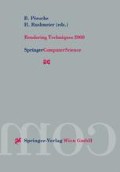Abstract
Acceleration structures used for ray tracing have been designed and optimized for efficient traversal of static scenes. As it becomes feasible to do interactive ray tracing of moving objects, new requirements are posed upon the acceleration structures. Dynamic environments require rapid updates to the acceleration structures. In this paper we propose spatial subdivisions which allow insertion and deletion of objects in constant time at an arbitrary position, allowing scenes to be interactively animated and modified.
Access this chapter
Tax calculation will be finalised at checkout
Purchases are for personal use only
Preview
Unable to display preview. Download preview PDF.
References
J. Amanatides and A. Woo, A fast voxel traversal algorithm for ray tracing, in Eurographics ’87, Elsevier Science Publishers, Amsterdam, North-Holland, Aug. 1987, pp. 3–10.
K. Bala, J. Dorsey, and S. Teller, Interactive Ray Traced Scene Editing using Ray Segment Tree, in Rendering Techniques ’99, pp. 31–44. Springer-Verlag, 1999.
A. Fujimoto, T. Tanaka, and K. Iwata, ARTS: Accelerated ray tracing system, IEEE Computer Graphics and Applications, 6 (1986), pp. 16–26.
V. Gaede and O. Günther, Multidimensional access methods, ACM Computing Surveys, 30 (1998), pp. 170–231.
A. S. Glassner, ed., An Introduction to Ray Tracing, Academic Press, 1989.
A. S. Glassner, Space subdivision for fast ray tracing, IEEE Computer Graphics and Applications, 4 (1984), pp. 15–22.
A. S. Glassner, Spacetime ray tracing for animation, IEEE Computer Graphics and Applications, 8 (1988), pp. 60–70.
M. J. Muuss, Towards real-time ray-tracing of combinatorial solid geometric models, in Proceedings of BRL-CAD Symposium, June 1995.
S. Parker, W. Martin, P.-P. Sloan, P. Shirley, B. Smits, and C. Hansen, Interactive ray tracing, in Symposium on Interactive 3D Computer Graphics, April 1999.
B. Smits, Efficiency issues for ray tracing, Journal of Graphics Tools, 3 (1998), pp. 1–14.
J. Spackman and P. Willis, The SMART navigation of a ray through an octtree, Computers and Graphics, 15 (1991), pp. 185–194.
K. Sung, A DDA octree traversal algorithm for ray tracing, in Eurographics ’91, W. Purgathofer, ed., North-Holland, sept 1991, pp. 73–85.
Author information
Authors and Affiliations
Editor information
Editors and Affiliations
Rights and permissions
Copyright information
© 2000 Springer-Verlag Wien
About this paper
Cite this paper
Reinhard, E., Smits, B., Hansen, C. (2000). Dynamic Acceleration Structures for Interactive Ray Tracing. In: Péroche, B., Rushmeier, H. (eds) Rendering Techniques 2000. EGSR 2000. Eurographics. Springer, Vienna. https://doi.org/10.1007/978-3-7091-6303-0_27
Download citation
DOI: https://doi.org/10.1007/978-3-7091-6303-0_27
Published:
Publisher Name: Springer, Vienna
Print ISBN: 978-3-211-83535-7
Online ISBN: 978-3-7091-6303-0
eBook Packages: Springer Book Archive

